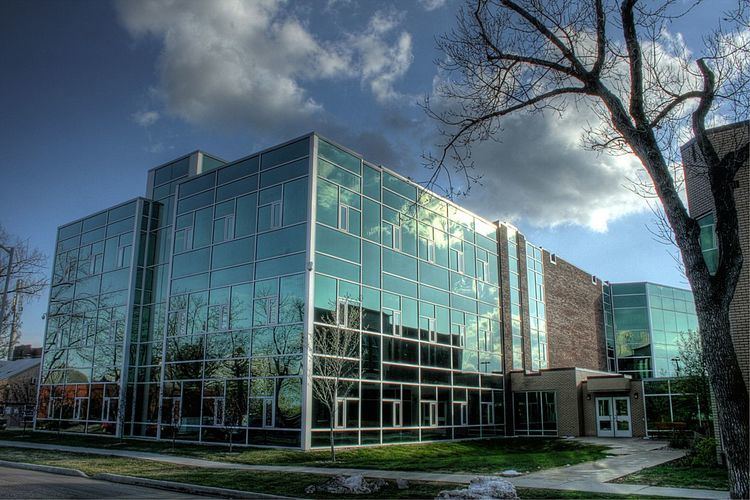Type Independent University President Dr. Tim Loreman Chancellor Allan Wachowich Number of students 1,770 | Established 1921 Undergraduates 1,640 Phone +1 780-479-8481 Mascot Thunder Colors Blue, Gold | |
 | ||
Motto Initium Sapientiae Timor Domini Motto in English The fear of the Lord is the beginning of wisdom Notable alumni Nathan Fillion, Ashley Callingbull‑Burnham, Benjamin Woodman Similar MacEwan University, The King's University, Northern Alberta Institute o, NorQuest College, Lakeland College Profiles | ||
Concordia university of edmonton
Concordia University of Edmonton, previously Concordia University College of Alberta, is an independent publicly funded university in Edmonton, Alberta, Canada. Accredited under the Alberta Post-secondary Learning Act, Concordia is primarily funded by the Government of Alberta, tuition, and private donations.
Contents
- Concordia university of edmonton
- Around concordia concordia university of edmonton campus video tour series
- History
- Programs and Facilities
- Crest
- Notable alumni
- Athletics
- References
Around concordia concordia university of edmonton campus video tour series
History
Concordia University of Edmonton was founded in 1921 as Concordia College by the Lutheran Church - Missouri Synod to prepare young men for preaching and teaching in the Christian church. It was essentially a high school for many decades. It introduced co-education in 1939, offering general study courses, and an accredited high school program. In 1967, Concordia began offering first-year university courses in affiliation with the University of Alberta. Affiliation for second-year courses began in 1975. The university graduated its first cohort of Bachelor of Arts and Bachelor of Science three-year degrees in 1988, gradually expanding to other disciplines and four-year programs. A formal separation between the high school and college (degree granting) was initiated in 1994.
The affiliation with the University of Alberta officially ended in 1991 by mutual agreement. Concordia College operated as a denominational college affiliated with the public sector until 1987, when the Province of Alberta allowed Concordia to start operating as a private degree-granting university college. Concordia changed its name from Concordia College to Concordia University College of Alberta in 1995. The high school program that had run within Concordia since 1939 separated into an independent institution called Concordia High School in 2000. Both institutions shared the same campus until July 2011. In 2014 the Alberta government announced that Concordia would be allowed to change its name, dropping the word "college" and allowing Concordia to call itself a university. On May 1, 2015, Concordia University College of Alberta was renamed Concordia University of Edmonton.
Although the university had indicated its intention to continue relationships with Lutheran organizations and alumni, in November 2015 Concordia removed references to Christianity from its mission statement, effectively self-identifying as a secular institution. Concordia's religious constituency had not fully funded the school since 1978 and in 2015, with religious financial support at 0.1 per cent of the school's $30 million budget, the board decided to secularize. The secularization was formally announced in April 2016.
Programs and Facilities
The university offers 45 majors and minors in the fields of Arts, Science and Management; 2 after-degree programs, 3 master's degrees, and several graduate certificates and diplomas. Through a faculty and course-sharing partnership, the University of Lethbridge maintains a small extension campus at the university. The Concordia Lutheran Seminary also shares the university grounds.
Campus life features a community orchestra, a touring choir, and regular drama productions. There is a dormitory for women (Eberhardt Hall), one for higher-year women (Wangerin House), and a men's dormitory (Founders Hall). The university has a gymnasium and a large athletic field on campus. In the past the field was sometimes used for spring practice by the Edmonton Eskimos football team.
Crest
Concordia's crest was designed in 1921 and was in continual use as a logo until 1991, when it was updated to remove the word "college" from the title. In 2010 the crest was retired as the visual identity of Concordia. It remains in use on legal documents as a seal, and on degree diplomas. A new logo was adopted in 2010, designed by Michelle McBride of Edmonton, Alberta. It reflects Concordia's front entrance of the historic Schwermann Hall, built in 1926, which also mirrors the castle church door in Wittenberg, Germany, on which Dr. Martin Luther nailed the 95 Theses, sparking the Reformation. Further, the logo's curved lines represents the shore and waters of the North Saskatchewan River, which lies directly below Concordia, in the Highlands neighborhood of Edmonton.
Notable alumni
Athletics
The Concordia Thunder compete in the Alberta Colleges Athletic Conference (Provincial Level) and the Canadian Colleges Athletic Association (National Level). Team sports include: badminton, basketball, curling, golf, hockey, soccer, cross country running, and volleyball. Each sport includes participation by both men and women on separate teams with the exception of Hockey which only has a men's team. Thunder alumni include: Andrew Parker, who is a well known basketball player who competes for the Edmonton Energy of the International Basketball League. Another notable Concordia alumnus, Daniel Veenstra, has recently become prominent in the diving world by placing a spot on the 2012 Canadian Olympic team. Jennifer Clayton, currently in her fourth year with the women's volleyball team has made a name for herself finishing last year as the ACAL leader in "digs and kills".
